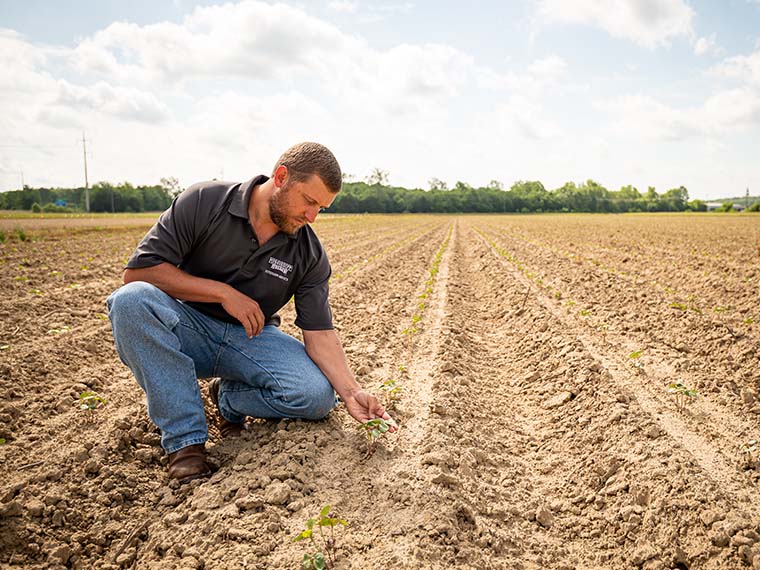The information presented on this page may be dated. It may refer to situations which have changed or people who are no longer affiliated with the university. It is archived as part of Mississippi State University's history.
FAYETTEVILLE, TENNESSEE NATIVE JAKE MCNEAL, has taken his love of the land-grant mission and applied it to his cotton research for a doctoral degree.
After growing up immersed in the world of farming, hunting, and fishing, McNeal earned his bachelor's degree in wildlife science from Auburn University. He advanced through several internships before beginning his MSU master's degree in agronomy, where he focused on irrigation strategies for multiple crops. McNeal is currently in his last year as a doctoral candidate in agronomy with a projected graduation date of May 2021. Research that he has conducted as part of the process has promising applications to maximize the efforts of cotton and soybean farmers.
McNeal is currently conducting three different experiments funded by Cotton Incorporated. Two of these experiments are hoping to define and clarify the best application and management practices of the common pesticide dicamba when mixed in a tank with various insecticides, specifically in regards to spray droplet size and carrier volume.
The first of these studies assesses the effectiveness of a dicamba-insecticide tank mix application to control Palmer amaranth and thrips in early-season cotton production systems.
"Palmer amaranth and thrips are annual issues for cotton producers, but the current label restrictions for all dicamba applications and the recommendations for optimal thrips control don't necessarily line up. This experiment is hoping to address this particular issue," McNeal said.
After completing two years of field studies, McNeal says the results are surprising.
"We are achieving the same level of thrips control with dicamba-insecticide tank mixes under the dicamba label restrictions as we are with insecticide-only applications. In all scenarios, we are achieving the same level of Palmer amaranth control with any dicamba-insecticide tank mix as we do when applying dicamba alone." McNeal said.
By showing that the same level of thrips control can be achieved when coupling dicamba with insecticide tank mixes, McNeal has highlighted the potential of allowing producers to combine multiple applications into a single trip through the field.
The second of his studies repeats the process, but rather than striving to understand the application's effectiveness on thrips control, it evaluates the effectiveness on tarnished plant bugs in pre-bloom cotton-production systems. McNeal shared that the results indicate as long as the chosen insecticide is Transform®, the dicamba-insecticide tank mix will be effective for controlling both Palmer amaranth and tarnished plant bugs.
The third of McNeal's studies focuses on cotton defoliation application methods, assessing the impact of various spray droplet sizes, carrier volumes, and single verses multiple application scenarios. McNeal and his team found that, for single applications, five gallons of water per acre resulted in more defoliation when compared to 20 gallons per acre and that spray droplet size did not impact defoliation in the single application. McNeal also included that - although multiple applications are oftentimes subjective decisions based on the particular system - if a second application is deemed necessary, higher carrier volumes and smaller spray droplet sizes are better options due to the combination creating more total spray droplets and more complete coverage.
"As we continue to move into a world of precision agriculture, our hope is that this research contributes to our overall understanding of how these and other application factors impact efficacy. Our only goal is to help our producers find both economic and environmental sustainability with their pesticide applications," McNeal said.
This goal is not only the touchstone of McNeal's research but serves as the most important factor in guiding his future career.
"As an agronomist and field scientist, I have the opportunity to do what I love and with a real purpose. I love working with our producers. They are the smartest, hardest-working people on the planet. The opportunity to serve them through research allows me to leverage my skillset to help our farmers. I can't imagine a career doing anything else," McNeal said.
This research is supported by Cotton, Incorporated.

